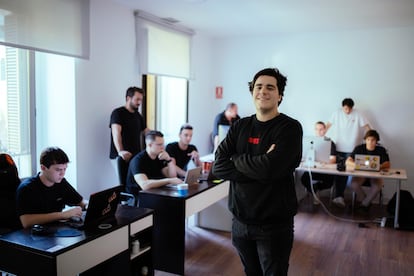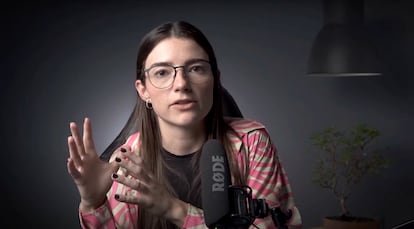LinkedIn shoots for TikTok’s virality
The workplace social network is shifting its focus to content creators, who are pouring in, thanks to the presence of large companies and the opportunities the platform offers to gain industry influence


The planet’s biggest job bulletin board has pinned up a sign: content creators welcome. If a few years ago, LinkedIn saw itself as a place where professionals could showcase their resumes and promote their personal brand, that landscape has begun to change. Following in the steps of TikTok and Instagram, LinkedIn is turning into a social network where users can help their content go viral, upload short videos and even share memes. All, of course, in the context of their profession and without dramatically shifting the formal tone that has characterized the platform since it was founded in 2002 in the United States. LinkedIn, which has belonged to Microsoft since 2016, reports that in the last year alone, “creator mode” accounts have risen from 13 to 16 million worldwide.
“LinkedIn is no longer the buttoned-up network for job seeking; people and brands are now leading with more human messages to introduce themselves,” says Beatriz Torres, who has led a lengthy career as an online publicist. She explains that the pandemic and working from home have compelled users to share the more emotional side of their jobs. That has opened the doors to new creators, who are finding communities through posts related to corporate wellbeing, personal finances, mediation or simply, advice on getting work and increasing sales.
Such is the case of María Begue, 28, who until 2022 was just another LinkedIn user. Her role on the social network began to change when she decided to post daily recommendations meant to help her contacts to build their personal brand. With messages like “the resume is a thing of the past” and “write something on the internet every day,” she began to build a community that today includes more than 90,000 followers. “Now I can make a living from this without needing to work another job,” she says. Her earnings come from selling personalized advice and access to pre-recorded courses that she offers through her LinkedIn account. She estimates that, depending on the month, a creator can earn between $539 to $18,313.
This phenomenon, according to experts, is in part the consequence of the arrival of a younger public to the platform. “The generation that grew up using Instagram and TikTok is entering the labor market and naturally engages in content creation,” says Brendan Gahan, a specialist in marketing through LinkedIn and the director of an agency of influencers on the social network. Gahan says that the platform is facilitating this approach with a series of tools like lives, short vertical videos, newsletters and podcasts, which have already achieved a fair amount of online success.

LinkedIn Spain’s Virginia Collera, who is in charge of its editorial section, breaks down the success its video format is seeing, to the tune of a 45% growth in views in 2024. She says that the platform’s team is inviting content creators to trainings so that they can take better advantage of the network’s tools, and that these trainings even extend to the communications teams of large Spanish companies. “We also want CEOs to make better moves on this platform,” she says. She believes this is one of the factors that is attracting new audiences: “The social network is increasingly being used by decision-makers at companies, which is an invitation to users to make themselves known.”
Jorge Branger, 28, is the founder of an agency that specializes in Linkedin influencers. He agrees that large companies are becoming more interested in their presence on the platform. “Investment funds and firms like Oracle and Nvidia don’t want to be on TikTok because that’s not where their target audience is, but on LinkedIn, they’re found the ideal territory for connecting with other companies,” he says. Branger and Gahan agree that the money that brands are open to paying for marketing campaigns on the platform is well above that of other networks like Instagram. “If in 2020, a company was offering $1,077 per post, today the number could be double,” says Branger, who has worked with brands like Santander and Vodafone.
“Lately, the B2B (company to company) model is moving more money worldwide, and LinkedIn is the platform that represents that,” says Branger, who has one of the top five most popular accounts in Spain, with close to 250,000 followers. That factor is what is driving content creators to make the leap to the social network, he argues.
“LinkedIn was getting old and users were leaving,” opines Torres, who thinks that these changes arrived at just the right time. The platform has seen an increase in its user base, reaching the one billion mark in January, a number that only Meta platforms and TikTok had previously achieved. In Spain, it has around 18 million accounts, according to the company, which says that the number of posts has also shot up by 41% between 2021 and 2023.
Change to the algorithm
Gahan says that the platform has also modified its algorithm to favor content creators, in contrast to companies like TikTok, which reward “likes” and views over more genuine forms of interaction (like shares and comments.) That strategy has been employed in the hopes of affording more visibility to those who are creating content specifically for LinkedIn. He says that while on TikTok, there are 40,000 accounts with more than a million followers, on LinkedIn that number stands at 80, worldwide.
Begue, who recently participated in a LinkedIn training for content creators, says that the rise of influencers on the platform is providing more work opportunities to copywriters, who write posts and newsletters from the accounts of others. In her case, she does her own copy. She admits that at first, she could spend several hours preparing her daily posts, but as time has passed, she’s gotten the system down, and dedicates on average 90 minutes to each publication.
In addition to recent trends, the network did already have its own influencers, the so-called “top voices” who were already benefiting from high visibility on LinkedIn. Santiago Íñiguez was among the first to receive that distinction in Spain. In his opinion, “the benefit is that it comes with mechanisms that communicate trustworthiness, like the scarce presence of bots and the almost non-existent propagation of hoaxes and fake news.”
Begue encourages those looking to take their first step on the job platform towards becoming active users to start creating posts. She understands that this can be a complicated proposal: “People are afraid of feeling judged, especially on a network with all their co-workers, but if you have a skill, it’s possible that you can sell it.” She says she started out having few expectations, though she always aspired to having her own business. “I thought that if I was able to build an audience, I’d be able to position myself in the professional world.”
Sign up for our weekly newsletter to get more English-language news coverage from EL PAÍS USA Edition
Tu suscripción se está usando en otro dispositivo
¿Quieres añadir otro usuario a tu suscripción?
Si continúas leyendo en este dispositivo, no se podrá leer en el otro.
FlechaTu suscripción se está usando en otro dispositivo y solo puedes acceder a EL PAÍS desde un dispositivo a la vez.
Si quieres compartir tu cuenta, cambia tu suscripción a la modalidad Premium, así podrás añadir otro usuario. Cada uno accederá con su propia cuenta de email, lo que os permitirá personalizar vuestra experiencia en EL PAÍS.
¿Tienes una suscripción de empresa? Accede aquí para contratar más cuentas.
En el caso de no saber quién está usando tu cuenta, te recomendamos cambiar tu contraseña aquí.
Si decides continuar compartiendo tu cuenta, este mensaje se mostrará en tu dispositivo y en el de la otra persona que está usando tu cuenta de forma indefinida, afectando a tu experiencia de lectura. Puedes consultar aquí los términos y condiciones de la suscripción digital.
More information
Archived In
Últimas noticias
Most viewed
- Charles Dubouloz, mountaineering star, retires at 36 with a farewell tour inspired by Walter Bonatti
- The Florida Keys tourist paradise is besieged by immigration agents: ‘We’ve never seen anything like this’
- CBS in crisis after pulling a report on Trump’s deportations to El Salvador (which later leaked online)
- Chevy Chase, the beloved comedian who was a monster off camera: ‘Not everyone hated him, just the people who’ve worked with him’
- From Gwen Stefani to Katy Perry: The MAGA drift of celebrity Democrats










































